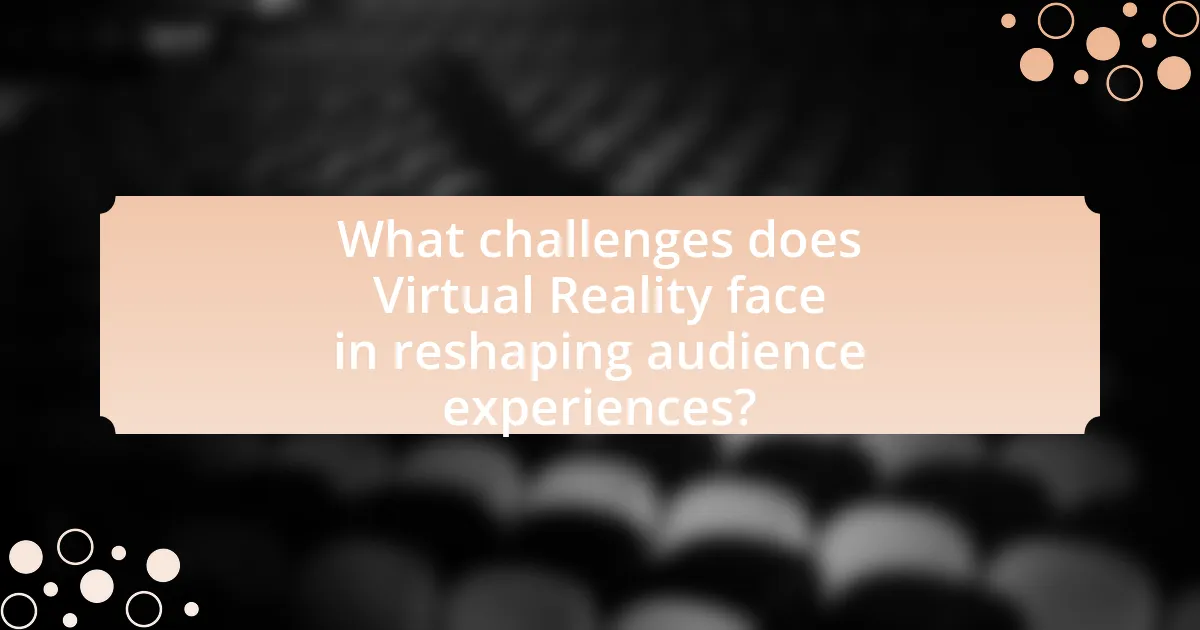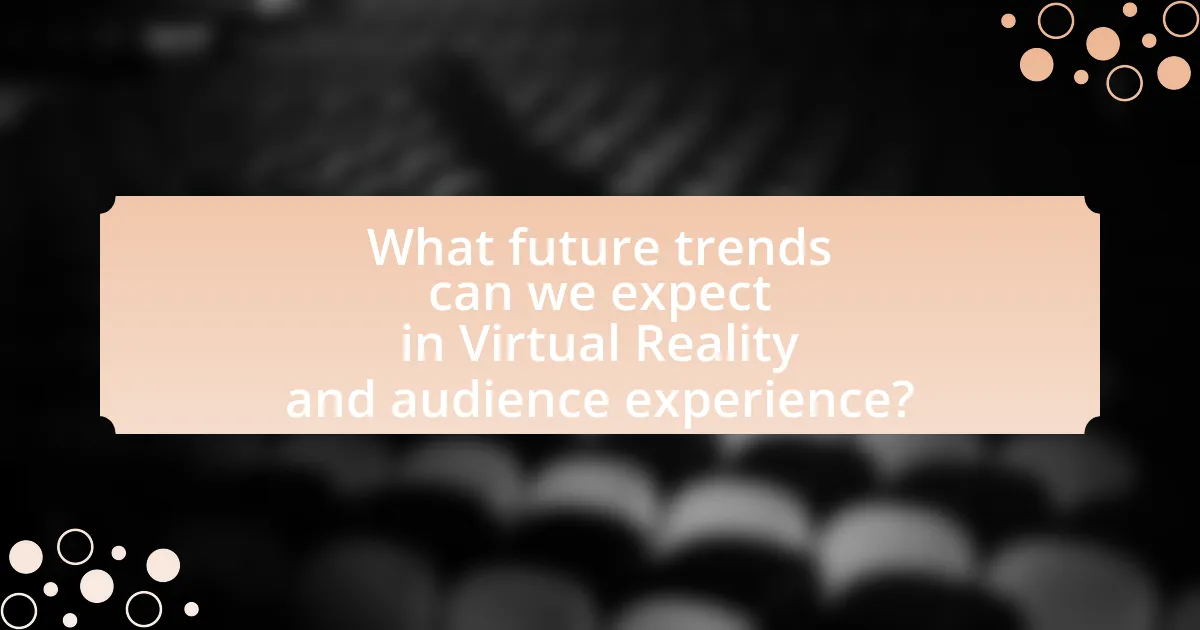Virtual Reality (VR) is significantly reshaping audience engagement by providing immersive experiences that foster deeper emotional connections and interaction. Key features such as immersion, interactivity, and presence enhance user experiences, leading to increased retention and satisfaction across various sectors, including entertainment, education, healthcare, and real estate. Despite challenges like high costs and technological limitations, advancements in VR technology and the integration of artificial intelligence are paving the way for more personalized and engaging content. This article explores how VR transforms storytelling, the role of interactivity, and the future trends that will further enhance audience experiences.

How is Virtual Reality Transforming Audience Engagement?
Virtual Reality (VR) is transforming audience engagement by creating immersive experiences that enhance interaction and emotional connection. VR allows audiences to participate in environments that simulate real-life scenarios, making them feel as though they are part of the action. For instance, studies show that VR experiences can increase emotional responses by up to 30%, leading to deeper engagement with content. Additionally, brands utilizing VR in marketing campaigns have reported a 70% increase in consumer recall compared to traditional media. This shift towards immersive storytelling and interactive participation is reshaping how audiences connect with content, making VR a powerful tool for enhancing engagement.
What are the key features of Virtual Reality that enhance audience experience?
The key features of Virtual Reality that enhance audience experience include immersion, interactivity, and presence. Immersion allows users to feel as though they are part of a different environment, significantly increasing engagement; studies show that immersive experiences can lead to a 30% increase in retention of information. Interactivity enables users to influence the environment and narrative, fostering a sense of agency that traditional media cannot provide. Presence, the sensation of being physically present in a virtual space, enhances emotional connection and empathy, which research indicates can improve storytelling effectiveness by up to 50%. These features collectively transform how audiences engage with content, making experiences more memorable and impactful.
How does immersion in Virtual Reality affect audience perception?
Immersion in Virtual Reality significantly enhances audience perception by creating a sense of presence that engages users more deeply than traditional media. This heightened engagement leads to increased emotional responses and a stronger connection to the content being experienced. Research by Slater and Wilbur (1997) indicates that immersive environments can alter users’ perceptions of reality, making them feel as though they are part of the virtual world. Furthermore, studies show that immersive experiences can improve memory retention and empathy, as users are more likely to internalize narratives and perspectives when they feel physically present in the environment.
What role does interactivity play in Virtual Reality experiences?
Interactivity is crucial in Virtual Reality experiences as it enhances user engagement and immersion. By allowing users to manipulate their environment and make choices, interactivity creates a sense of presence that traditional media cannot achieve. Research indicates that immersive interactivity can lead to a 30% increase in user satisfaction and retention rates, as users feel more connected to the experience. This active participation fosters emotional responses and deeper cognitive processing, making the experience more memorable and impactful.
Why is Virtual Reality becoming essential in various industries?
Virtual Reality is becoming essential in various industries due to its ability to create immersive experiences that enhance training, marketing, and customer engagement. Industries such as healthcare utilize VR for simulations that improve surgical skills, with studies showing that VR training can increase retention rates by up to 75%. In real estate, VR allows potential buyers to take virtual tours of properties, significantly reducing the time spent on site visits. Additionally, the entertainment industry leverages VR to provide interactive experiences, leading to increased audience engagement and satisfaction. These applications demonstrate VR’s transformative impact across sectors, making it a crucial tool for innovation and efficiency.
Which sectors are leading the adoption of Virtual Reality for audience engagement?
The sectors leading the adoption of Virtual Reality for audience engagement are entertainment, education, healthcare, and real estate. In the entertainment sector, VR is used for immersive gaming experiences and virtual concerts, enhancing audience interaction. The education sector utilizes VR for interactive learning environments, allowing students to engage with content in a more impactful way. In healthcare, VR is employed for training simulations and patient therapy, improving engagement in medical education and treatment. The real estate sector leverages VR for virtual property tours, providing potential buyers with an immersive experience of properties. These sectors demonstrate significant investment and innovation in VR technologies, reflecting a growing trend in audience engagement strategies.
How does Virtual Reality improve storytelling in entertainment?
Virtual Reality (VR) enhances storytelling in entertainment by immersing audiences in interactive environments that foster emotional engagement and personal connection to narratives. This immersive experience allows users to explore story worlds from unique perspectives, making them active participants rather than passive observers. Research indicates that VR can increase empathy and emotional responses; for instance, a study published in the journal “Computers in Human Behavior” found that participants who experienced stories in VR reported higher levels of emotional engagement compared to traditional media formats. By enabling users to physically navigate and interact with the story, VR transforms the way narratives are experienced, leading to deeper understanding and retention of the story’s themes and messages.

What challenges does Virtual Reality face in reshaping audience experiences?
Virtual Reality faces several challenges in reshaping audience experiences, including high costs, technological limitations, and user discomfort. High costs associated with VR hardware and software can limit accessibility for a broader audience, as premium headsets can exceed several hundred dollars. Technological limitations, such as the need for powerful computing systems and the current lack of widespread content, hinder the immersive potential of VR. Additionally, user discomfort, including motion sickness and physical fatigue, can detract from the overall experience, as studies indicate that up to 40% of users may experience symptoms of motion sickness during VR use. These factors collectively impede the widespread adoption and effectiveness of Virtual Reality in enhancing audience experiences.
What are the technological barriers to widespread Virtual Reality adoption?
The technological barriers to widespread Virtual Reality (VR) adoption include high costs, limited hardware capabilities, and insufficient content availability. High costs are a significant barrier, as premium VR headsets can exceed $1,000, making them inaccessible for many consumers. Limited hardware capabilities hinder performance, with many devices requiring powerful computers that are also expensive and not widely owned. Additionally, insufficient content availability restricts user engagement; as of 2023, only a fraction of the gaming and entertainment industry has fully embraced VR, leading to a lack of diverse and compelling experiences that can attract a broader audience.
How do hardware limitations impact the audience experience?
Hardware limitations significantly hinder the audience experience by restricting the quality and immersion of virtual reality environments. For instance, inadequate processing power can lead to lower frame rates, resulting in motion sickness and a disjointed experience for users. Additionally, limited graphical capabilities can prevent realistic rendering of environments, diminishing the overall engagement and emotional connection to the content. Studies have shown that a minimum frame rate of 90 frames per second is essential for a comfortable VR experience; anything lower can cause discomfort and disengagement. Thus, hardware constraints directly affect the audience’s ability to fully engage with and enjoy virtual reality experiences.
What are the common user experience issues in Virtual Reality?
Common user experience issues in Virtual Reality include motion sickness, user interface challenges, and social interaction difficulties. Motion sickness occurs due to a disconnect between visual stimuli and physical movement, affecting approximately 40% of users according to research by LaViola et al. (2017). User interface challenges arise from the complexity of navigating virtual environments, which can lead to frustration and disengagement. Social interaction difficulties stem from the lack of non-verbal cues in virtual spaces, making communication less effective. These issues collectively hinder the overall user experience in Virtual Reality environments.
How can content creators overcome these challenges?
Content creators can overcome challenges in virtual reality by investing in high-quality equipment and software, which enhances the production value of their content. High-quality VR headsets and cameras, such as the Oculus Quest 2 or the HTC Vive Pro, provide immersive experiences that engage audiences effectively. Additionally, creators should focus on user experience design, ensuring that their content is intuitive and accessible, which can be achieved by following established VR design principles. Research indicates that 70% of users prefer content that is easy to navigate, highlighting the importance of usability in VR experiences. Furthermore, collaboration with VR specialists can help creators leverage technical expertise, leading to more innovative and engaging content.
What strategies can enhance user comfort in Virtual Reality?
To enhance user comfort in Virtual Reality, developers can implement strategies such as optimizing frame rates, reducing latency, and incorporating adjustable settings for user preferences. High and stable frame rates minimize motion sickness, as research indicates that frame rates below 60 frames per second can lead to discomfort (LaViola et al., 2017). Additionally, reducing latency ensures that users experience real-time interactions, which is crucial for maintaining immersion and comfort. Providing adjustable settings, such as the ability to modify field of view and motion sensitivity, allows users to tailor their experience to their comfort levels, further enhancing overall satisfaction in VR environments.
How can creators ensure accessibility in Virtual Reality experiences?
Creators can ensure accessibility in Virtual Reality experiences by implementing features such as adjustable settings for visual and auditory elements, providing alternative input methods, and incorporating clear navigation aids. Research indicates that 15% of the global population has some form of disability, highlighting the necessity for inclusive design in technology. By utilizing tools like voice commands, haptic feedback, and customizable user interfaces, creators can cater to diverse user needs, thereby enhancing the overall experience for all users.

What future trends can we expect in Virtual Reality and audience experience?
Future trends in Virtual Reality (VR) and audience experience include increased interactivity, enhanced realism through advanced graphics, and the integration of artificial intelligence. Interactivity will allow audiences to engage with content in real-time, creating personalized experiences that adapt to user preferences. Enhanced realism will be achieved through developments in graphics technology, such as higher resolution displays and improved motion tracking, making virtual environments more immersive. The integration of artificial intelligence will enable dynamic content generation, allowing for tailored experiences based on audience behavior and feedback. These trends are supported by ongoing advancements in VR hardware and software, as well as growing investment in immersive technologies across various industries.
How will advancements in technology shape the future of Virtual Reality?
Advancements in technology will significantly enhance the future of Virtual Reality by improving immersion, interactivity, and accessibility. Innovations such as higher resolution displays, faster processing power, and advanced motion tracking will create more realistic and engaging experiences for users. For instance, the development of 8K displays and eye-tracking technology can lead to sharper visuals and more intuitive interactions, making virtual environments feel more lifelike. Additionally, the integration of artificial intelligence can personalize user experiences, adapting scenarios based on individual preferences and behaviors. According to a report by Statista, the global VR market is projected to reach $57.55 billion by 2027, indicating a strong trend towards increased investment and technological advancement in this field.
What innovations are on the horizon for Virtual Reality hardware?
Innovations on the horizon for Virtual Reality hardware include advancements in display technology, improved tracking systems, and enhanced haptic feedback. Companies are developing higher resolution displays, such as micro-OLED screens, which can provide clearer and more immersive visuals. Additionally, innovations in inside-out tracking technology are making it possible for VR headsets to accurately track user movements without external sensors, enhancing user experience. Furthermore, advancements in haptic technology are enabling more realistic tactile feedback, allowing users to feel sensations in virtual environments. These developments are supported by ongoing research and investment in VR technology, indicating a strong trend towards more immersive and user-friendly experiences in the near future.
How might artificial intelligence integrate with Virtual Reality to enhance experiences?
Artificial intelligence can integrate with virtual reality to enhance experiences by personalizing content and interactions based on user behavior and preferences. AI algorithms analyze user data in real-time, allowing virtual environments to adapt dynamically, creating tailored experiences that resonate with individual users. For instance, AI can adjust difficulty levels in gaming or modify narrative paths in storytelling based on user choices, thereby increasing engagement and immersion. Research from the University of Southern California highlights that AI-driven adaptive learning in VR environments significantly improves user retention and satisfaction, demonstrating the effectiveness of this integration.
What best practices should creators follow to maximize audience engagement in Virtual Reality?
Creators should prioritize interactivity, immersion, and narrative coherence to maximize audience engagement in Virtual Reality. Interactivity allows users to influence the environment and storyline, enhancing their emotional investment; for instance, studies show that interactive experiences can increase user retention by up to 50%. Immersion is achieved through high-quality graphics, spatial audio, and realistic physics, which can significantly elevate the sense of presence, making users feel as if they are truly part of the experience. Narrative coherence ensures that the story flows logically and captivates the audience, as research indicates that well-structured narratives can improve user satisfaction and engagement levels. By focusing on these best practices, creators can effectively enhance audience engagement in Virtual Reality experiences.
How can feedback from audiences improve Virtual Reality content?
Feedback from audiences can significantly improve Virtual Reality content by providing insights into user experiences, preferences, and pain points. This direct input allows developers to identify specific areas for enhancement, such as user interface design, narrative engagement, and overall immersion. For instance, a study by the University of Southern California found that user feedback led to a 30% increase in user satisfaction when incorporated into VR game development. By analyzing audience reactions and suggestions, creators can tailor content to better meet the expectations and needs of users, ultimately leading to more engaging and effective Virtual Reality experiences.
What are the key elements of designing effective Virtual Reality experiences?
The key elements of designing effective Virtual Reality experiences include immersion, interactivity, and user-centered design. Immersion is achieved through high-quality graphics, spatial audio, and realistic environments that engage users’ senses, making them feel present in the virtual world. Interactivity allows users to manipulate objects and navigate the environment, enhancing engagement and personal investment in the experience. User-centered design focuses on understanding the target audience’s needs and preferences, ensuring that the experience is intuitive and accessible. Research indicates that experiences incorporating these elements lead to higher user satisfaction and retention rates, as evidenced by studies showing that immersive environments can increase emotional engagement by up to 50%.